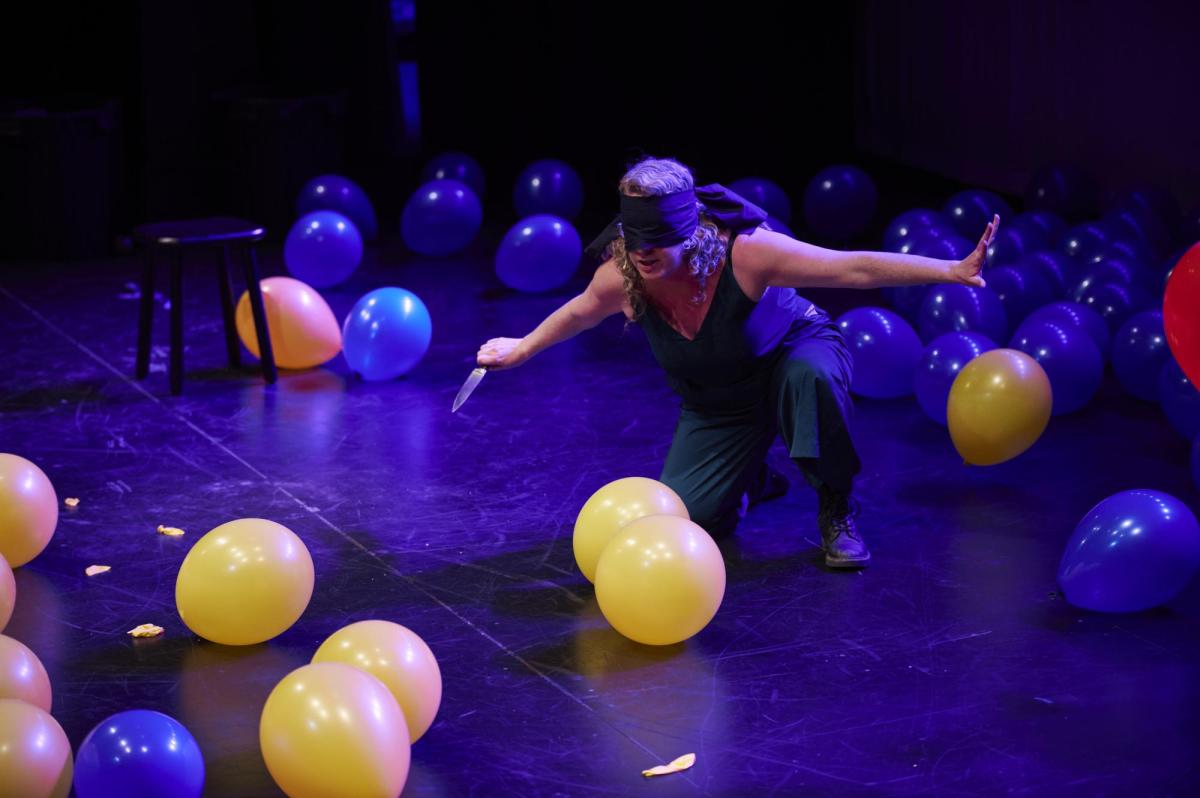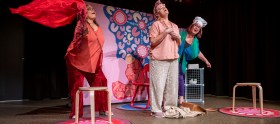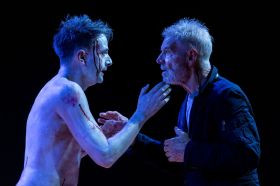Waterloo is about the moral dilemmas that an intimate relationship can present us with. When you are attracted to, and then involved over years with a person of apparently opposite philosophies and world views, how can you help but be changed, or reinforced, as you both navigate the minefields of choosing well, fairly and honourably, so you can sleep at night?
The show begins with a toy military tank sporting a red helium balloon, which tootles around the stage amid a sea of blue balloons, attacking at random. Then Bron Batten appears on screen in a filmed paint-ball session that sets the scene for the battle of ideas and philosophies that are central to the show, emphasising the effects on participants of real-life land battles.
Batten addresses audiences in between her meditations on the years-long relationship she had with a British army officer, returned from Afghanistan with PTSD and profoundly changed by the experience; ‘right wing’ to her ‘left wing’ – these days a less and less useful identifier, which is a point made in this piece.
Waterloo: voting time
At one point Batten asks the audience to vote – half having their say individually, with pencil and paper, as we still largely do in Australia, half grouped in the autocracy cohort, with one audience member making the decisions between “yes” and “no”, for the whole group, with some argy-bargy on a few points. The questions raised for us to ponder were all challenging – the toughest decisions between life and death, betrayal, honour and short-term ruthlessness for the greater good. The “yes” and “no” results are screened at the end and are worth focusing on, as they are surprising and enlightening. The running total are kept throughout the season. A breakdown between the individual voters’ answers and the autocrat’s will be informative, too.
This stimulated much animated discussion into the night. A group of women on my tram afterwards were still finding agreement on issues Batten raised.
Surely this is what theatre is about – making us think, challenging us to see the world through the eyes of Batten and her lover, whose job was to make the tough calls, albeit at the long-term expense of his mental and emotional health. The pairing of these two disparate people changed them both – his politics were adjusted by her questioning opposition, her sense of herself and her own behaviour wryly confessed to being less than ideal.
Waterloo: inventive
There is some inventive staging of ideas – it’s a noisy night in the theatre! – and lots of audience participation. Despite being miked, a lack of affect vocally meant some words were unclear, so a few ideas need a bit more clarity of delivery. That, and a slightly slower pace as Batten adjusts to the space at Theatre Works, will fine tune responses from the audience.
Read: Theatre review: Dear Son, Bille Brown Theatre
Metaphors made for vivid visuals: explosions and implosions of colour and noise abound. Balloons float, tumble and inflate; we slap them around as they bounce past, like ideas that need batting around. Is living in a bubble the way we protect ourselves from making choices and feeling the effects of having made them in the longer term? How responsible is each of us for the well-being of our fellow citizens of the world, and at what cost?
Waterloo
Theatre Works, Melbourne
Created and performed by Bron Batten
Outside eye direction: Gary Abrahams
Tickets: $25-$48
Waterloo will be performed until 12 July 2025.
Discover more arts, games and screen reviews on ArtsHub and ScreenHub.
Also on ArtHub:
My Cousin Frank review: Rhoda Roberts engages at Arts Centre Melbourne
Francis ‘Frank’ Roberts made history in 1964 when he became the first Aboriginal to represent Australia at the Olympics. It is a sad indictment of the time that he had to travel under a British passport as a subject because he was not considered an Australian citizen. The struggles and triumphs of Frank are both personal and a reflection of those of his people. My Cousin Frank brings his story and the history that shaped it to life in a compelling production. Read more …






